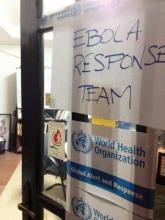The struggle to defeat Ebola viral disease continues globally, although it may not always make the headlines. To catch up on what you may have missed, here are some notable news items and journal articles published over the past few weeks that are worth a look.
New research reveals that the Ebola virus is typically cleared from the blood within 16 days – meaning that the risk of infection from contact with a survivor is low. However, an exception to this is transmission via sexual intercourse due to the virus’ presence in semen for many months after a patient has otherwise recovered. Contact with the patient’s blood is also a longer-term risk.
A report in Clinical Infectious Diseases assesses two cases of Ebola viral disease (EVD) in pregnant women who survived, initially with intact pregnancies. Both patients had live second trimester fetuses in utero following cure, but each woman ultimately delivered a stillborn fetus with persistent EVD–polymerase chain reaction amniotic fluid positivity. The investigators say this highlights the need for research on possible infectivity of amniotic fluid after convalescence of the mother.
According to new research, extracts of the medicinal plant Cistus incanus attack Ebola and HIV virus particles and prevent them from multiplying in cultured cells. Since the antiviral activity of Cistus extracts differs from all clinically approved drugs, the researchers say Cistus-derived products could be an important complement to currently established drug regimens.
Investigators at the CDC used mice engrafted with human immune cells as a model for Ebola virus infection and disease progression. They demonstrated that mice devoid of their native immune response and reconstituted with a human innate and adaptive immune system are susceptible to infection and die of disease within approximately 2 weeks after inoculation with wild-type Ebola virus. Mice appear to offer a unique model for investigating the human immune response in EVD and an alternative animal model for EVD pathogenesis studies and therapeutic screening.
A study published in Scientific Reports shows the ability of a vaccine vector, based on a common herpesvirus called cytomegalovirus expressing Ebola virus glycoprotein, to provide protection against Ebola virus in the experimental rhesus macaque, non-human primate model. Investigators say the study is a step forward for the development of conventional Ebola virus vaccines for use in humans.
Researchers at the Yale School of Public Health developed computational models for disease transmission and infection progression to estimate the repercussions of the 2014-2015 West African Ebola outbreak on populations already at risk for malaria, HIV/AIDS, and tuberculosis. They estimated that a 50% reduction in access to healthcare services during the Ebola outbreak exacerbated malaria, HIV/AIDS, and tuberculosis mortality rates by additional death counts of 6,269 in Guinea; 1,535 in Liberia; and 2,819 in Sierra Leone.
A broad panel of neutralizing, anti–Ebola virus antibodies have been isolated from a survivor of the recent Zaire outbreak. Investigators said 77% of the monoclonal antibodies (mAbs) neutralize live EBOV, and several mAbs exhibit unprecedented potency. They said the results provide a framework for the design of new EBOV vaccine candidates and immunotherapies.
The Ebola epidemic in West Africa provides valuable lessons for how to respond to infectious disease epidemics generally, according to an analysis in Science. The report says rebuilding local health care infrastructures, improving capacity to respond more quickly to outbreaks, and considering multiple perspectives across disciplines during decision-making processes are the key areas for action.
A multicenter non-randomized trial of Ebola virus patients in Guinea found that favipiravir monotherapy, along with standardized care, merits further study in patients with medium to high viremia, but not in those with very high viremia. The results also confirm that viral load is a strong predictor of mortality.
According to a report in the Journal of Infectious Diseases, the support from the World Health Organization’s polio program infrastructure, particularly the coordination mechanism adopted, the availability of skilled personnel in the polio program, and lessons learned from managing the polio eradication program greatly contributed to the speedy containment of the 2014 Ebola virus disease outbreak in Nigeria.
On Twitter @richpizzi


